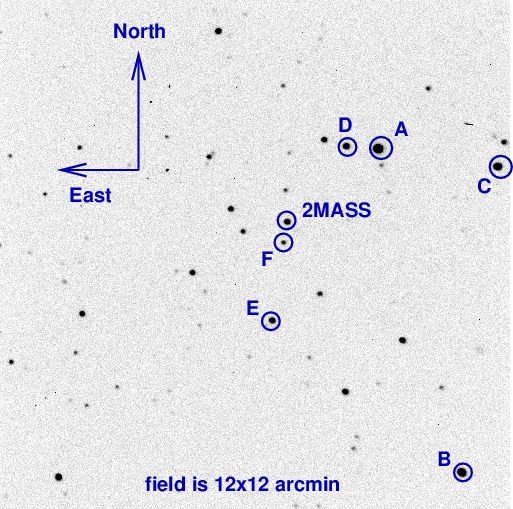
On the night of Jun 09/10, 2016, I acquired a set of observations of the cataclysmic variable star 2MASS_J16211735+4412541. I recorded roughly one complete cycle, showing two big dips.
I also acquired images of SN 2016coj in NGC 4125, and some pictures of the Moon while waiting for the sky to grow dark.
The main setup was:
Notes from the night:
This cataclysmic variable star was recently the subject of several telegrams:
The object is located at
RA = 16:21:17.35 Dec = +44:12:54.1
A chart of the field is shown below. The size of the chart is about 12 by-12 arcminutes.

Entries for one of the marked comparison stars from the UCAC4 follows:
star UCAC4 B V ---------------------------------------------------- A 672-059554 13.214 12.191 ----------------------------------------------------
Conditions were good. The quarter moon set early in the run, and the skies were dark. Measurements of the sky background value show a smooth decrease as the field rose, until dawn came. Just one 20-minute interruption by clouds.
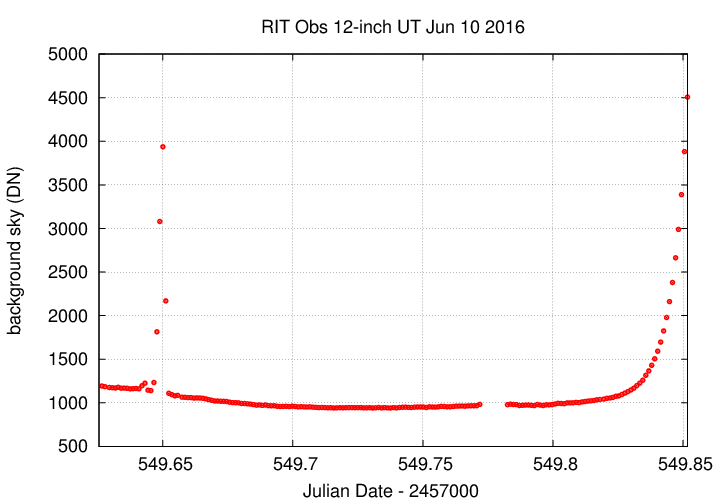
The guider did a good job of keeping the telescope fixed in place. There was a small jump in RA near the end of the run, around image 129 at JD 549.787.
Using aperture photometry with a radius of 4 pixels (radius of 5.7 arcsec), I measured the instrumental magnitudes of a number of reference stars and the target. Following the procedures outlined by Kent Honeycutt's article on inhomogeneous ensemble photometry, I used all stars available in each image to define a reference frame, and measured each star against this frame.
Sigma-vs-mag plots show that the floor was about 0.004 mag. 2MASS is the big outlier at mag 2.8.
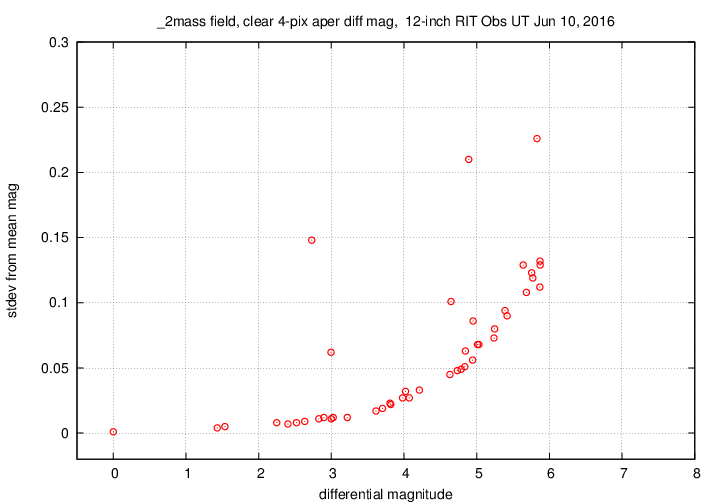
Image adjustment factor shows a brief spike early due to clouds, then a gradual rise as dawn approached.
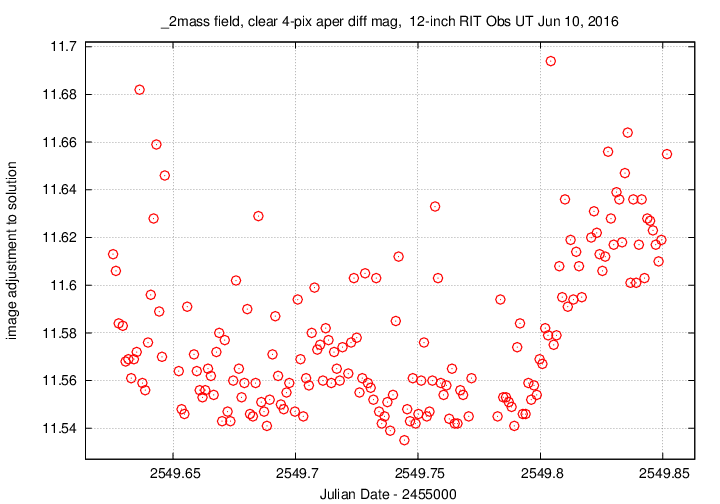
Here are light curves of the variable and the field stars:
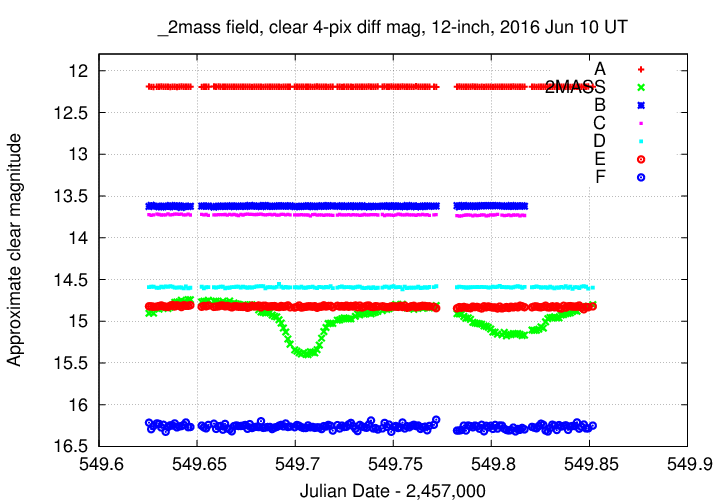
I used the UCAC value for the V-band magnitude of star "A" = UCAC4 672-059554 to shift the ensemble magnitudes to the standard V-band scale -- but remember that these are UNFILTERED measurements.
Here's a closeup on the variable:

You can download my measurements below. A copy of the header of the file is shown to explain the format.
# Measurements of 2MASSJ16211735+4412541 made at RIT Obs, Jun 10, 2016 UT, # in good conditions. # by Michael Richmond, using 12-inch Meade and SBIG-ST9E. # Exposures 90 seconds long, no filter. # Tabulated times are midexposure (FITS header time - half exposure length) # and accurate only to +/- 1 second (??). # 'mag' is a differential magnitude based on ensemble photometry # using a circular aperture of radius 5.7 arcseconds. # which has been shifted so UCAC4 672-059554 has mag=12.191 # which is its V-band mag according to UCAC4. # # UT_day JD HJD mag uncert Jun10.12549 2457549.62549 2457549.62766 14.904 0.014 Jun10.12662 2457549.62662 2457549.62879 14.886 0.013 Jun10.12778 2457549.62778 2457549.62995 14.903 0.014
Here's a picture of the Moon, taken through the B-band filter with an exposure time of 0.1 seconds. Just fun!
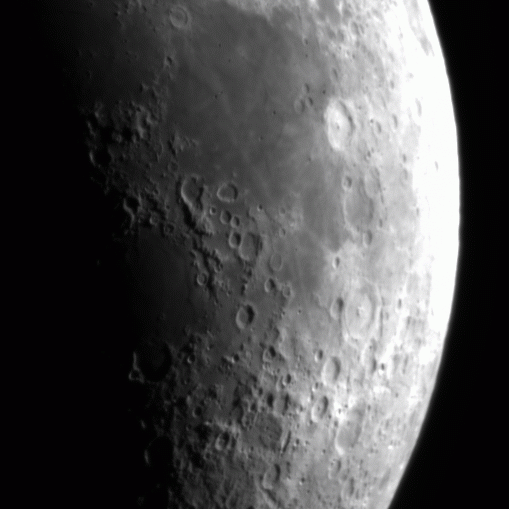
SN 2016coj is a Type Ia supernova in the relatively nearby galaxy NGC4125. It was discovered by the KAIT group some time before maximum light:
NGC 4125 RA = 12:08:05.7 Dec = +65:10:30 (J2000)
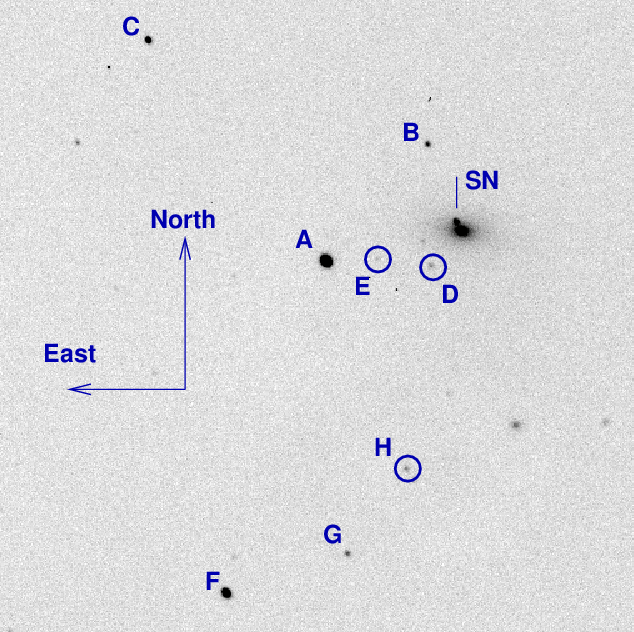
There are, alas, no really good sources of photometry for the stars marked above. I have created an interim set of magnitudes using the UCAC4 and converting the SDSS r and i magnitudes into Johnson-Cousins R and I via the conversion formulae of Jester et al. (2005). I hope to replace these interim values with better ones at some point.
letter B sigB V sigV R sigR I sigI ------------------------------------------------------------------------- A 10.981 0.004 9.888 0.006 9.247 0.032 8.651 0.036 B 15.202 0.004 14.130 0.005 13.621 0.032 13.146 0.035 C 13.320 0.004 12.671 0.006 12.302 0.032 11.955 0.036 D 15.939 0.003 15.038 0.007 14.370 0.031 13.749 0.034 F 13.066 0.004 11.663 0.006 10.947 0.032 10.282 0.035 G 15.047 0.006 14.365 0.006 13.977 0.032 13.613 0.035 -------------------------------------------------------------------------
I took 10 images per filter of the SN and its host galaxy. I was able to guide in VRI, but not B-band.
I used the rotsub technique to remove the galaxy's light, as best I could. It's not perfect.
Using aperture photometry with a radius of 4 pixels (radius of 5.5 arcsec), I measured the instrumental magnitudes of a number of reference stars and the target. Following the procedures outlined by Kent Honeycutt's article on inhomogeneous ensemble photometry, I used all stars available in each image to define a reference frame, and measured each star against this frame. I used the interim reference magnitudes above plus color terms which I am currently revising -- so please treat these results as preliminary to convert the ensemble instrumental magnitudes to the standard Johnson-Cousins BVRI scale.
Results from this evening are:
filter mag mag_uncert Julian Date SN B = 13.199 +/- 0.089 (ens 0.044 zp 0.077) 2457549.58866 SN V = 13.068 +/- 0.045 (ens 0.031 zp 0.032) 2457549.59553 SN R = 13.032 +/- 0.059 (ens 0.024 zp 0.054) 2457549.60074 SN I = 13.400 +/- 0.119 (ens 0.074 zp 0.093) 2457549.60681
Last modified 6/21/2016 by MWR.